Fusion-induced apoptosis contributes to thymocyte depletion by a pathogenic human immunodeficiency virus type 1 envelope in the human thymus
- PMID: 16956934
- PMCID: PMC1642149
- DOI: 10.1128/JVI.01382-06
Fusion-induced apoptosis contributes to thymocyte depletion by a pathogenic human immunodeficiency virus type 1 envelope in the human thymus
Abstract
The mechanisms of CD4(+) T-cell depletion during human immunodeficiency virus type 1 (HIV-1) infection remain incompletely characterized. Of particular importance is how CD4(+) T cells are depleted within the lymphoid organs, including the lymph nodes and thymus. Herein we characterize the pathogenic mechanisms of an envelope from a rapid progressor (R3A Env) in the NL4-3 backbone (NL4-R3A) which is able to efficiently replicate and deplete CD4(+) thymocytes in the human fetal-thymus organ culture (HF-TOC). We demonstrate that uninterrupted replication is required for continual thymocyte depletion. During depletion, NL4-R3A induces an increase in thymocytes which uptake 7AAD, a marker of cell death, and which express active caspase-3, a marker of apoptosis. While 7AAD uptake is observed predominantly in uninfected thymocytes (p24(-)), active caspase-3 is expressed in both infected (p24(+)) and uninfected thymocytes (p24(-)). When added to HF-TOC with ongoing infection, the protease inhibitor saquinavir efficiently suppresses NL4-R3A replication. In contrast, the fusion inhibitors T20 and C34 allow for sustained HIV-1 production. Interestingly, T20 and C34 effectively prevent thymocyte depletion in spite of this sustained replication. Apoptosis of both p24(-) and p24(+) thymocytes appears to be envelope fusion dependent, as T20, but not saquinavir, is capable of reducing thymocyte apoptosis. Together, our data support a model whereby pathogenic envelope-dependent fusion contributes to thymocyte depletion in HIV-1-infected thymus, correlated with induction of apoptosis in both p24(+) and p24(-) thymocytes.
Figures

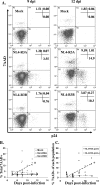
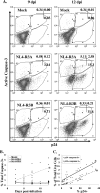
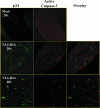
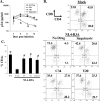
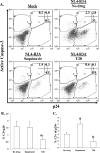
Similar articles
-
Type I interferon contributes to CD4+ T cell depletion induced by infection with HIV-1 in the human thymus.J Virol. 2011 Sep;85(17):9243-6. doi: 10.1128/JVI.00457-11. Epub 2011 Jun 22. J Virol. 2011. PMID: 21697497 Free PMC article.
-
The heptad repeat 2 domain is a major determinant for enhanced human immunodeficiency virus type 1 (HIV-1) fusion and pathogenicity of a highly pathogenic HIV-1 Env.J Virol. 2009 Nov;83(22):11715-25. doi: 10.1128/JVI.00649-09. Epub 2009 Sep 2. J Virol. 2009. PMID: 19726524 Free PMC article.
-
Characterization of a thymus-tropic HIV-1 isolate from a rapid progressor: role of the envelope.Virology. 2004 Oct 10;328(1):74-88. doi: 10.1016/j.virol.2004.07.019. Virology. 2004. PMID: 15380360 Free PMC article.
-
HIV-1 replication and pathogenesis in the human thymus.Curr HIV Res. 2003 Jul;1(3):275-85. doi: 10.2174/1570162033485258. Curr HIV Res. 2003. PMID: 15046252 Free PMC article. Review.
-
[The current progress in the development of HIV-1 fusion inhibitors].Yao Xue Xue Bao. 2010 Feb;45(2):184-93. Yao Xue Xue Bao. 2010. PMID: 21351428 Review. Chinese.
Cited by
-
Thymic plasmacytoid dendritic cells are susceptible to productive HIV-1 infection and efficiently transfer R5 HIV-1 to thymocytes in vitro.Retrovirology. 2011 Jun 3;8:43. doi: 10.1186/1742-4690-8-43. Retrovirology. 2011. PMID: 21639903 Free PMC article.
-
Type I interferon contributes to CD4+ T cell depletion induced by infection with HIV-1 in the human thymus.J Virol. 2011 Sep;85(17):9243-6. doi: 10.1128/JVI.00457-11. Epub 2011 Jun 22. J Virol. 2011. PMID: 21697497 Free PMC article.
-
Host and Viral Factors in HIV-Mediated Bystander Apoptosis.Viruses. 2017 Aug 22;9(8):237. doi: 10.3390/v9080237. Viruses. 2017. PMID: 28829402 Free PMC article. Review.
-
Lac-regulated system for generating adenovirus 5 vaccine vectors expressing cytolytic human immunodeficiency virus 1 genes.J Virol Methods. 2009 Sep;160(1-2):101-10. doi: 10.1016/j.jviromet.2009.04.028. Epub 2009 May 3. J Virol Methods. 2009. PMID: 19409930 Free PMC article.
-
The heptad repeat 2 domain is a major determinant for enhanced human immunodeficiency virus type 1 (HIV-1) fusion and pathogenicity of a highly pathogenic HIV-1 Env.J Virol. 2009 Nov;83(22):11715-25. doi: 10.1128/JVI.00649-09. Epub 2009 Sep 2. J Virol. 2009. PMID: 19726524 Free PMC article.
References
-
- Alimonti, J. B., T. B. Ball, and K. R. Fowke. 2003. Mechanisms of CD4+ T lymphocyte cell death in human immunodeficiency virus infection and AIDS. J. Gen. Virol. 84:1649-1661. - PubMed
-
- Biard-Piechaczyk, M., V. Robert-Hebmann, V. Richard, J. Roland, R. A. Hipskind, and C. Devaux. 2000. Caspase-dependent apoptosis of cells expressing the chemokine receptor CXCR4 is induced by cell membrane-associated human immunodeficiency virus type 1 envelope glycoprotein (gp120). Virology 268:329-344. - PubMed
-
- Bonyhadi, M. L., L. Rabin, S. Salimi, D. A. Brown, J. Kosek, J. M. McCune, and H. Kaneshima. 1993. HIV induces thymus depletion in vivo. Nature 363:728-732. - PubMed
Publication types
MeSH terms
Substances
Grants and funding
LinkOut - more resources
Full Text Sources
Research Materials
Miscellaneous

